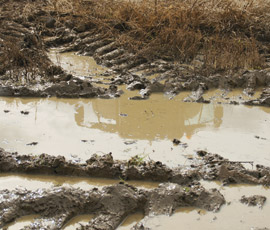Tread little and lightly on wet and sticky soils

Displaying a picture of a traction engine, Harper Adams University senior lecturer David White says: “Our ancestors knew something – keep off the soil.
“If a tillage operation isn’t going to be of benefit, don’t do it,” he urges.
Mr White highlights the importance of ballasting tractors correctly to achieve the “sweet spot” wheel slip figure of 8-15%. This would provide optimum traction with minimal soil damage, he explains.
All implements had critical working depths. “Never work deeper than you need to. As a rule of thumb, if you double the depth you quadruple the force needed to pull it,” he says.
For tined cultivators, the critical depth is six times the tine width, he notes. “Always check what the implement is actually doing.”
Backward facing tines, surprisingly perhaps, needed more pulling than those inclined forward at the same depth. “So consider lifting them out if the going’s difficult – they just add to the draft need.”
Worn tines, such as worn blades on a forage harvester, were false economy, he cautions.
Tyre pressures when field working should be reduced to the lowest recommended by the manufacturer for a given load, he adds. Compaction at depth was hard to undo, so growers should avoid creating it by keeping vehicles with high tyre pressures off their fields.
Mr White’s advice to help growers cope with this spring’s tricky conditions are:
- Make as few passes over the field as possible.
- Work headlands last – or not at all.
- Don’t rush – resist the temptation to fill the drill fully.
- Don’t force seed into poor soil conditions – it might lead to a costly re-drill.
- Allow green material to stay as long as possible. Kill it with glyphosate as late as possible.
- Dig a hole with a spade to check cultivation work for smearing.
- Direct drill or use minimum tillage on untouched stubbles.
- For ploughed but unplanted land:
- If OK below plough depth, cultivate as little as possible and plant.
- If compacted below plough depth, check if dry enough to loosen. Needs low axle weight and low ground pressure. Take care not wreck the loose soil.
- For ploughed and cultivated land not yet planted – if left weather-proof, ie pressed, use minimal tillage then drill.
- For cultivated land (possibly disced), but not drilled – do as little as possible to get an appropriate tilth.
- For really tricky conditions – broadcast and harrow.
- Last resort – leave fallow.
The speakers were at the Soil Management Workshop, held earlier this year, as part of a Harper Adams Soil & Water Management Centre workshop at Wiltshire’s Lackham College to give farmers practical advice on draining their land

